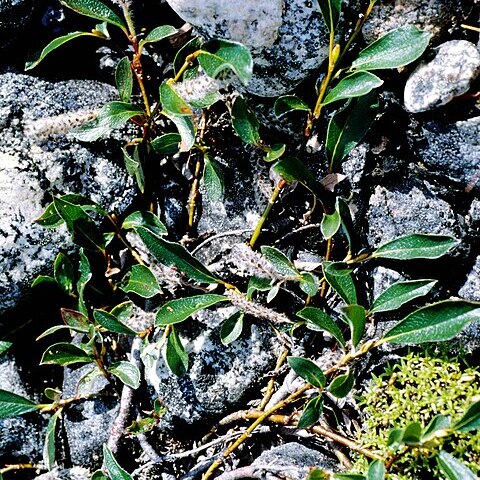Shrubs or trees, 0.1-9 m, (sometimes forming clones by layering). Stems (sometimes decumbent); branches yellow-brown, red-brown, or violet, not to strongly glaucous, glabrous or pubescent; branchlets yellow-brown, red-brown, or violet, glabrous, pilose, pubescent, moderately densely villous, or short-silky, (buds caprea-type). Leaves: stipules (sometimes marcescent), rudimentary or foliaceous (small and usually brownish) on early ones, rudimentary or foliaceous on late ones, (narrowly ovate to oblong, 1-2.5(-4.5) mm), apex acute; petiole shallowly grooved adaxially, 2-9(-13) mm, glabrous, pilose, or short-silky adaxially; largest medial blade (sometimes hemiamphistomatous), narrowly oblong, narrowly elliptic, elliptic, or oblanceolate, 20-36-65 × 5-13-23 mm, 1.7-2.8-4.7 times as long as wide, base cuneate or convex, margins sometimes slightly revolute basally, entire, or, sometimes, crenulate or serrulate, apex acute, acuminate, or convex, abaxial surface glaucous, glabrous or sparsely silky, hairs (white, sometimes also ferruginous) straight or wavy, adaxial highly glossy, glabrous or sparsely short-silky; proximal blade margins entire; juvenile blade reddish or yellowish green, glabrous, puberulent, pubescent, or densely long-silky abaxially, hairs white, sometimes also ferruginous. Catkins flowering before leaves emerge; staminate stout, subglobose, or globose, 12-41 × 10-20 mm, flowering branchlet 0-4 mm; pistillate densely flowered, slender, or stout to globose, 15-67 (-70 in fruit) × 8-18 mm, flowering branchlet 0-6 mm; floral bract dark brown or black, 1-3.2 mm, apex acute, convex, or rounded, sometimes 2-fid, abaxially hairy, hairs straight. Staminate flowers: adaxial nectary narrowly oblong or oblong, 0.4-1.1 mm; filaments distinct, glabrous or sparsely hairy basally; anthers purple turning yellow, shortly cylindrical, 0.5-0.7 mm. Pistillate flowers: adaxial nectary oblong, square, or ovate, 0.4-1.3 mm, shorter to longer than stipe; stipe 0.3-0.8 mm; ovary pyriform, short-to long-silky, sometimes slightly bulged below styles; ovules 11-16 per ovary; styles 0.5-2 mm; stigmas slenderly to broadly cylindrical, 0.36-0.52-1.1 mm. Capsules (2.5-)5.5-6 mm. 2n = 76, 57.
More
Erect shrub 1–3 m; twigs stoutish, divaricate, chestnut to red-purple or brown, puberulent at first, soon glabrous and shining; stipules small or more often none; petioles 4–10 mm; lvs rather crowded, narrowly elliptic or elliptic-oblanceolate or narrowly obovate, 3–6(–8) × 1–2.5(–3.5) cm, acute at both ends or the largest obtuse at base, entire or sometimes ± crenate-serrulate, glabrous and glossy above, sparsely sericeous to glabrous and glaucescent beneath, the primary lateral veins numerous, closely spaced; catkins precocious (reputedly sometimes coetaneous–not provided for in the key), sessile, 2.5–5 cm; scales 2–3 mm, black, long-villous; stamens 2; frs lanceolate, 4–7 mm, finely sericeous, subsessile, the pedicels only 0.1–0.5 mm; style 1–1.5 mm; 2n=76. Wet meadows, lake-shores, streambanks, and rocky places; Lab. to Yukon, s. to the mts. of Me., N.H., and Vt., and to n. Minn. and the w. cordillera. (S. phylicifolia ssp. planifolia)
Arctic, alpine, subalpine, and boreal meadows and riverbanks, streams, seeps, snowflush areas, treed bogs, fens, sandy-loam, rocky igneous and limestone substrates; at elevations from 100-4,000 metres.


